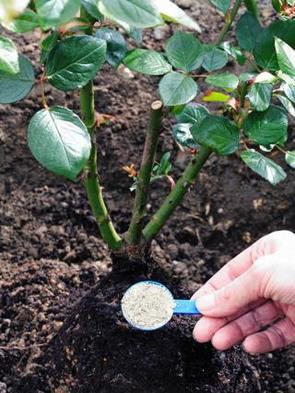Recommendations For Fertilizing Roses In The Kansas City Area
|
All fertilization programs start with a soil test for pH and base fertility. The pH of the soil needs to be between 6.0 and 6.5 for optimal availability of nutrients from the soil. Soils in the Kansas City area generally have a pH above 7.0. The pH can be lowered with the addition of soil sulfur, or raised with an application of lime. Our region’s soils generally contain adequate amounts of phosphorus and potassium. Nitrogen is usually needed because rain and irrigation leaches it out of the soil. The soil test results will guide you in adjusting the pH and supplementing your soil with the correct nutrients. ► Also See Rose Soil Testing Tips When to Fertilize
Start fertilizing in April, and make the last application no later than mid-August. For large shrub roses, adjust the amounts to no more than twice the portions listed below. Remember that more is not better. Over-fertilized plants attract insect pests and have less resistance to disease. |
How Much Fertilizer
Roses need 2 to 4 pounds of nitrogen per 1000 square feet of garden every growing season. It should be applied in one pound increments, applied 2-4 times throughout the growing season. Whether using a chemical fertilizer or an organic fertilizer, it should contain a combination of slow release and fast release nitrogen to provide even nutrition through the growing season.
Roses need 2 to 4 pounds of nitrogen per 1000 square feet of garden every growing season. It should be applied in one pound increments, applied 2-4 times throughout the growing season. Whether using a chemical fertilizer or an organic fertilizer, it should contain a combination of slow release and fast release nitrogen to provide even nutrition through the growing season.
|
How to Apply
Here is a simple formula for any dry or granular fertilizer to convert from pounds of fertilizer and square feet of garden to the treatment of one rose bush. If using lawn fertilizer with a formula of around 30-3-3 (30% nitrogen (N), 3 % phosphorus (P), and 3% potassium(K)), spread one teaspoon of fertilizer. (Be very careful that the lawn fertilizer does NOT contain weed killer!) If a balanced formula such as 10-10-10 is used, about one tablespoon of fertilizer is needed for each application. For a fertilizer containing 2% to 5% nitrogen, such as manure or alfalfa meal, ¼ cup fertilizer will be needed for each application. If you use a liquid fertilizer, follow the directions on the product package, and assume that this equals one fertilizer treatment. Pull back the mulch around the base of the plant and sprinkle the fertilizer evenly in a circle. Always water your roses before you fertilize and again after spreading the fertilizer under the bush. This will prevent leaf burn from the fertilizer being too concentrated in the soil. |
Fertilization in The Laura Conyers Smith Municipal Rose Garden For fertilizer recommendations in other parts of the country, contact your local extension office and/or seek advice from a nearby local: |









